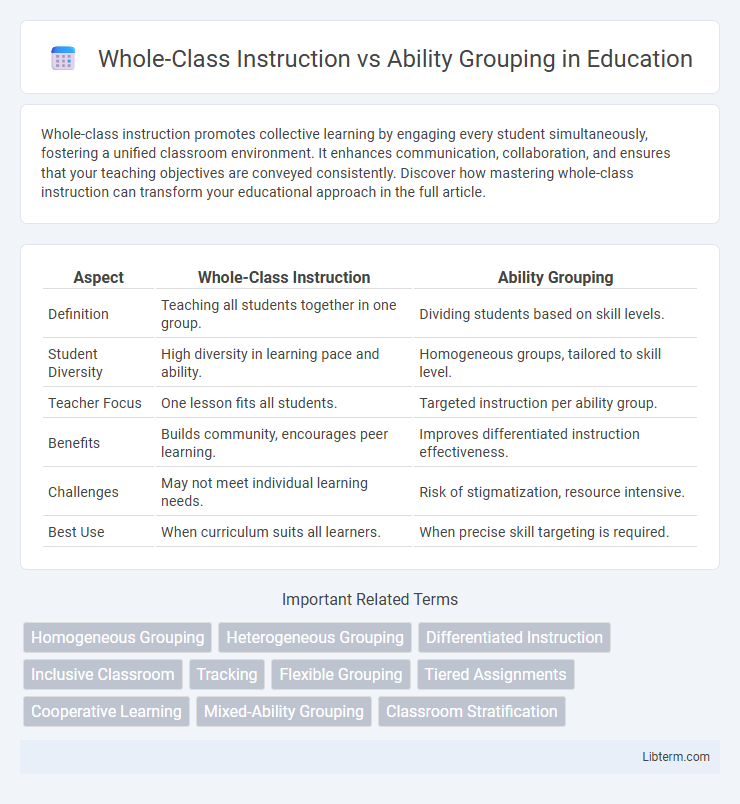Whole-class instruction promotes collective learning by engaging every student simultaneously, fostering a unified classroom environment. It enhances communication, collaboration, and ensures that your teaching objectives are conveyed consistently. Discover how mastering whole-class instruction can transform your educational approach in the full article.
Table of Comparison
| Aspect | Whole-Class Instruction | Ability Grouping |
|---|---|---|
| Definition | Teaching all students together in one group. | Dividing students based on skill levels. |
| Student Diversity | High diversity in learning pace and ability. | Homogeneous groups, tailored to skill level. |
| Teacher Focus | One lesson fits all students. | Targeted instruction per ability group. |
| Benefits | Builds community, encourages peer learning. | Improves differentiated instruction effectiveness. |
| Challenges | May not meet individual learning needs. | Risk of stigmatization, resource intensive. |
| Best Use | When curriculum suits all learners. | When precise skill targeting is required. |
Introduction to Whole-Class Instruction and Ability Grouping
Whole-class instruction involves teaching all students together, promoting uniform curriculum delivery and fostering collective engagement. Ability grouping divides students based on skill levels, allowing tailored instruction that targets specific learning needs. Both strategies aim to enhance educational outcomes by balancing standardization with individualized support.
Defining Whole-Class Instruction
Whole-class instruction involves teaching all students simultaneously, using a unified curriculum and pacing to engage diverse learners. This method promotes collective participation and immediate feedback, fostering a cohesive learning environment. It contrasts with ability grouping by emphasizing inclusivity and uniform content delivery rather than segmented skill levels.
What is Ability Grouping?
Ability grouping is an educational practice that categorizes students into groups based on their skill levels or academic performance, allowing instruction to be tailored to specific learning needs. This method aims to provide targeted support and challenge by grouping students with similar abilities, which can enhance engagement and progression. Critics argue it may reinforce achievement gaps and limit peer learning opportunities compared to whole-class instruction.
Historical Context and Trends
Whole-class instruction, rooted in traditional education systems since the 19th century, emphasized uniform teaching to maintain curriculum consistency and classroom management. Ability grouping, gaining prominence in the mid-20th century, introduced differentiated instruction by categorizing students based on skill levels to target specific learning needs. Over time, educational reforms and research on equity and student outcomes have influenced shifts between these methods, reflecting evolving priorities in pedagogy and inclusivity.
Advantages of Whole-Class Instruction
Whole-class instruction promotes equitable access to learning by engaging all students simultaneously, fostering collaboration and diverse perspectives. This method maximizes instructional time efficiency and supports consistent curriculum delivery, ensuring cohesive understanding across the classroom. Research shows whole-class discussions enhance critical thinking and communication skills, benefiting overall student achievement.
Benefits of Ability Grouping
Ability grouping enhances personalized learning by tailoring instruction to students' specific skill levels, fostering faster academic progress. It promotes targeted support, allowing teachers to address individual needs more effectively and boost student confidence. Research shows ability grouping can improve engagement and motivation, leading to higher achievement in subjects like math and reading.
Potential Drawbacks of Each Approach
Whole-class instruction can lead to slower pace and less personalized learning, as it may not address diverse student needs or learning speeds effectively. Ability grouping risks reinforcing achievement gaps by limiting lower-performing students' exposure to higher-level content and peer modeling. Both approaches may reduce opportunities for differentiated instruction, impacting student engagement and academic growth.
Impact on Student Achievement and Engagement
Whole-class instruction promotes consistent engagement by addressing diverse learning needs simultaneously, fostering collaborative skills and collective understanding. Ability grouping can increase achievement for high-performing students through tailored challenges but may inadvertently lower engagement and self-esteem in lower-performing groups. Research indicates mixed impacts on student achievement, suggesting that balanced instructional strategies integrating both approaches can optimize learning outcomes and engagement.
Equity and Inclusivity Considerations
Whole-class instruction fosters equity by providing all students access to the same curriculum and learning opportunities, reducing the risk of stigmatization often associated with ability grouping. Ability grouping can inadvertently reinforce achievement gaps and limit inclusivity by segregating students based on perceived proficiency, which may affect motivation and self-esteem. Implementing differentiated strategies within whole-class settings promotes inclusivity by addressing diverse learning needs without isolating learners.
Choosing the Right Approach for Your Classroom
Choosing the right instructional approach depends on classroom diversity, learning objectives, and student needs. Whole-class instruction promotes inclusivity and consistent pacing, while ability grouping allows targeted support and challenges tailored to different skill levels. Evaluating assessment data and student engagement helps educators decide between fostering collaboration or addressing individual learning gaps effectively.
Whole-Class Instruction Infographic

 libterm.com
libterm.com